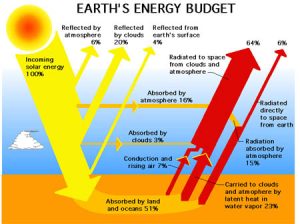4 Understanding Earth’s Energy Budget

The Earth’s Energy Budget represents the balance between the Sun’s incoming energy and the Earth’s outgoing energy. [1][2] This budget is crucial for regulating the temperature of the planet. In many ways, the Earth’s Energy Budget works like any budget; to stay balanced, the amount coming in must match the amount going out. Its like a bank account – if you withdraw the same amount of money you deposit, the account balance will remain the same. Your balance will increase if you put more money into your account than you take out. In the case of the Earth’s Energy Budget, the incoming energy from the Sun needs to equal the outgoing energy from the Earth for Earth’s temperature to stay the same – if less goes back out to space than comes in, the temperature increases. [3]
A limited number of things can alter the energy balance of the entire planet. The following are key factors that can impact the global energy balance:
- Greenhouse gases (heat-trapping gases)
- Volcanic Eruptions
- Changes in the Sun’s energy
- Human activities that add aerosols into the atmosphere
- Changes in land use and land cover
The subsequent chapters will discuss how these factors impact Earth’s Energy Budget and influence climate. This exploration will help us understand how human activities have altered Earth’s climate.
- "What Is Earth’s Energy Budget? Five Questions with a Guy Who Knows." NASA, 16 Aug. 2017, www.nasa.gov/feature/langley/what-is-earth-s-energy-budget-five-questions-with-a-guy-who-knows. Accessed 14 Aug. 2023. ↵
- The Global Climate Observing System (n.d.). Earth Radiation Budget. Retrieved June 29, 2023, from https://gcos.wmo.int/en/essential-climate-variables/earth-radiation#:~:text=The%20Earth%20Radiation%20Budget%20(at,only%20be%20measured%20from%20space. ↵
- NOAA, National Weather Service. "The Earth-Atmosphere Energy Balance." National Weather Service, JetStream, https://www.noaa.gov/jetstream/atmosphere/energy Accessed 5 May 2023. ↵
Energy balance is "the difference between the total incoming and total outgoing energy. If this balance is positive, warming occurs; if it is negative, cooling occurs. Averaged over the globe and over long time periods, this balance must be zero. Because the climate system derives virtually all its energy from the Sun, zero balance implies that, globally, the absorbed solar radiation, that is, incoming solar radiation minus reflected solar radiation at the top of the atmosphere and outgoing longwave radiation emitted by the climate system are equal." (IPCC AR6 Glossary)
When most people say "aerosol," they often refer to a specific type of product that produces an aerosol spray, like hairspray. When you press the nozzle, liquid particles suspended in the gas come out. When scientists talk about aerosols, they refer to a broad category of tiny solid or liquid particles or droplets- a typical size between 0.01 and 10 mm - suspended in a gas, which can occur naturally or be a result of human activities. For example, when you see dust floating in a beam of sunlight you see a natural example of aerosols suspended in the air, while soot from gas powered cars is an example of aerosols from human activities. (See IPCC 2018)
